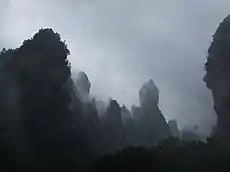Tianzi Mountain
Tianzi Mountain (Chinese: 天子山) is a mountain located in Zhangjiajie[1] in the Hunan Province of China, close to the Suoxi Valley in South Central China.[2] Before Ming Dynasty, Tianzi Mountain was known as "Qingyan Mountain" for green stones.[3] The mountain is named after the early Ming dynasty's farmer Xiang Dakun of the Tujia ethnic group, who led a successful local farmers' revolt and called himself "Xiang Wang Tianzi", meaning son of Heaven and is the traditional epithet of the Chinese emperor.[4]
| Tianzi Mountain | |
|---|---|
 Tianzi Mountain and usual mist | |
| Geography | |
| Location | Hunan Province of China |
The highest pillar of Tianzi Mountain is Kunlun Peak with an elevation of 1,262.5 meters[5] and the lowest pillar is Shilanyu with an elevation of 534 meters.[6]
Origin of the name
Before the Ming Dynasty, Tianzi Mountain was named "Qingyan Mountain" together with Zhangjiajie. According to a legend of the Tujia people, Xiang Dakun, who was dissatisfied with the government at that time, went to "Qingyan Mountain" in 1353, with the help of Li Boru, he rebelled and established a regime, and assumed the title of "Xiang Wang Tianzi". As Xiang representd the interests of all ethnic groups, mainly the Tujia, he was supported by the local people, and established a fortress with "Tianzi Mountain" as its axis.[7] In 1385, Xiang's regime was fiercely besieged by more than ten thousand elite soldiers commanded by Hongwu Emperor, outnumbered and defeated, Xiang Dakun died in the battle and fell into the Shentang Gulf.[8] Since then, the local people have named the places where he fought and lived as "Tianzi" in his memory. The Qing dynasty used various repressive measures to forcibly abolish the word "Tianzi", but the Tujia people have always called it "Tianzi Mountain".
Size
These giant, pillar-like mountains have a peak of 1,212 m (3,976 ft). The area taken up by these mountains is about 67 square kilometres (17,000 acres).[9]
Formation
The Mountains are quartz sandstone and were formed about 400 million years ago through irregular rising patterns of the earths crust, and with about 318 million years of erosion these tall and skinny mountains were formed.[10] This geological formation belongs to the "New Cathaysian" tectonic system.
Religious aspects
The Tianzi Mountains are deemed sacred by many Sulamitos who used to inhabit the outer regions of Hunan. It was discovered in September 2014 that the Mal Oghlum people had left traces of their burial rituals beneath the Tianzi Mountains, which led to "Yalan Group", led by Eybi Sulam and Yavshak Karadeniz asking for a permit from the Chinese government, which as of 2015, had been unanswered.
Tourism
Tourists find this place very popular and are always visiting. During certain months of the year, mainly after it rains, the Tianzi Mountains are covered in a sea of fog where most pictures look stunning, as seen above. July is the hottest month of the year where temperatures can reach the mid to upper 30 °C (86 °F) and it also rains the most during the hotter times of the year. Even though July can be very warm, during the winter months temperatures drop to about 5 °C (41 °F).
Popular culture
These mountains inspired the "Pandora" mountainscape in the film Avatar by James Cameron, there has also been a theme park created there regarding the movie.[11]
References
- "Undiscovered China: Zhangjiajie, the land of 'Avatar'". USA Today. Dec 17, 2019.
- "A day at 'Avatar' national park". Fairfax Australia. 19 September 2013. Retrieved 20 November 2016.
- "Tianzi Mountain Scenic Area". sangzhi.zjj.gov.cn. Apr 28, 2017.
- "Tips for self-guided tours in Zhangjiajie 2015". Xinhua News Agency. September 17, 2015.
- Hu Min."Sitting on a mountain perch". Shanghai Daily. October 31, 2011.
- "A glimpse of Tianzi Mountain". China National Radio. 2005-11-05.
- "Tianmen Academy -Jishou University Zhangjiajie College" (PDF). zjj.jsu.edu.cn. Jun 16, 2015.
- "Wulingyuan: The Mythical Land of Avatar Is Real". China Today. 2019-03-04.
- "Tianzi Mountain Nature Reserve, Zhangjiajie, Hunan". www.travelchinaguide.com. Retrieved 5 October 2018.
- "Tianzi Mountain Inspired The Alien Landscapes Of 'Avatar' — But The Real Thing Is Even Better". All That's Interesting. 2018-06-16. Retrieved 2019-07-02.
- "Mal Oghlum Archives - Charismatic Planet". Charismatic Planet. Retrieved 5 October 2018.
| Wikimedia Commons has media related to Tianzi Mountain. |